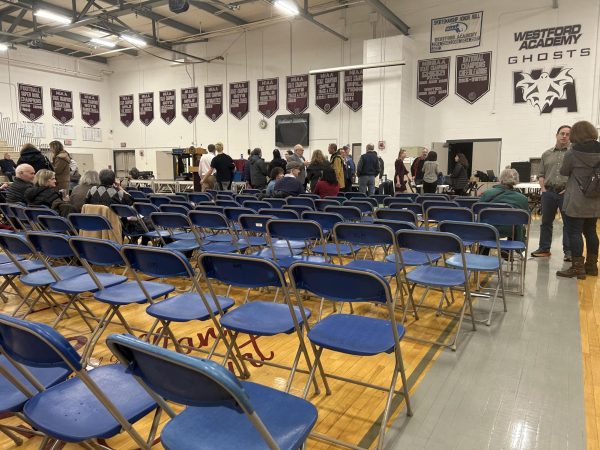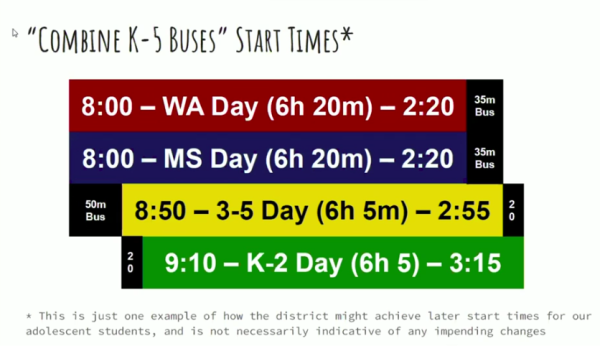New cap and gown policy sparks controversy among seniors
This is what graduation might look like if all students were to wear maroon.
December 24, 2019
On December 17, 2018, Superintendent Bill Olsen issued a final approval of the graduation cap and gown policy, which took effect in the 2019-20 schoolyear. The policy changed from “boys wear maroon, girls wear white” to a choice of either a maroon or white gown for the Class of 2019. For the class of 2020, however, a change from having a choice of color to having all students wear maroon was issued.
The revised cap and gown policy comes per guidelines set by the Massachusetts Department of Elementary and Secondary Education (DESE). In 2011, An Act Relative to Gender Identity was released and changed many Massachusetts statutes to include the prohibition of discriminating on the basis of gender identity.
Following the act came the release of a document titled “Guidance for Massachusetts Public Schools Creating a Safe and Supportive School Environment: Nondiscrimination on the Basis of Gender Identity,” which clarified some of the applications of the new act.
“The new law on gender identity provides a good opportunity for schools to review their gender-distinct policies. For example, some schools require students to wear gender-based garb for graduation […] Schools should eliminate gendered policies and practices such as these,” the document said.
The decision was in the works for around four months before the final decision was made. In a School Committee meeting on November 19, 2018, the new changes in graduation robe policies were first brought to the attention of the public by the School Committee Policy Subcommittee members (Megan Eckroth, Gloria Miller, and Alicia Mallon). The decision was also part of various policies contributing to the revision of the Dress Code policy, P5323, which had the goal of removing gender distinctions from required school dress in all events and situations.
When asked about the decision to change to one color and not just having a choice, Olsen explained that allowance is only part of inclusivity.
“One word we always talk about in issues of sexual preference or gender identity […] it drives me crazy sometimes when people use the word ‘tolerance.’ […] Well, tolerance means you’re willing to put up with something, and that’s not what we’re all about here. It should be respect and understanding, and not just the word ‘tolerance,’” Olsen said.
In addition to simply gender inclusivity, both Olsen and the School Committee Policy Subcommittee have expressed that this decision would not be made in solidarity: other schools are following the same trend of making all their robes a single color. After conducting a survey of other school districts in Massachusetts, Olsen found that around 70%, or 59 out of the 85 schools interviewed, had made a switch from two colors to one robe color as their cap and gown policy.
However, many students are unhappy with the decision. When class of 2019 senior Morgan Freud put out a survey on Facebook in 2018, out of 259 total responses, 94% voted to keep the robe color a choice. And when senior Allison Wakefield put out an Instagram poll earlier this year, around 50% of students agreed that if they were given the option, they would buy a white gown.
As a result, students such as Wakefield took matters into their own hands.
“I was upset about [the decision] because I think that there should be a choice of color. Part of it is I like white. Just a personal opinion. And then part of it’s also that graduation is in June, it’s hot, and white isn’t hot as maroon. […] But then also part of it was just like students didn’t have a choice […] it was just the school committee. […] And I thought about it, and I was like, ‘What can I do to keep the choice?’” Wakefield said.
Wakefield began by talking with her guidance counselor to see how many people she would need to allow for the purchase of white gowns. Then, she called Jostens, the company in charge of class rings and graduation attire at WA, to see if she could order white gowns separately from the school.
Although, according to Olsen, the definitive consequences for failing to wear a maroon gown at graduation are unclear, the administration has suggested that students would face some consequences.
“The only thing they would threat was to not let us walk at graduation. And that’s been a pervasive thing that [administration has] thrown around,” Wakefield said.
However, this does not sit well with Wakefield.
“With the assumed consequence of not getting to walk at graduation if you wear a white gown, that angered me even more, because they teach us in history, and even in my English classes […] to stand up for what we want. And then [when] we want to go do that in the real world, and we want to wear a white gown at graduation, they say, ‘No, sit down, you can’t walk.’ So, they’re very hypocritical,” Wakefield said.
In spite of the criticism from many students, Olsen continues to stand by his decision.
“From time to time, change is difficult for people to accept, and this is one of those situations […] we want to put everyone on an equal playing field,” Olsen said.
Many students, although also preferring to have two colors, fully understand the decision and the importance of the impact it has on gender non-conforming students.
“I don’t have personal experience with questioning my gender identity but I think that this is an option that works for people who are dealing with that. […] I feel like I don’t really have a say in what the gown color should be because it doesn’t really affect me. The only reason that I like certain colors is because I just prefer the color better and it wouldn’t be an issue that would cause me stress or anxiety. So, I think that we should be thinking about the people who this is going to affect on a deeper level than just liking one color over the other,” senior Elle Whitehead said.
When seniors were asked about their thoughts on buying their own gowns, Lasya Dutta argued that this situation was not a situation worthy of protest.
“I just don’t see why your last day of your schoolyear you’re going to go against the administration for something this petty. Some people are like ‘I don’t care if I don’t walk at graduation’ and I’m like, ‘Are you really going to not walk at graduation—what you’ve been working for for 4 years—for the color of your cap and gown?’” Dutta said.
At the end of the day, Olsen said the decision was intended for the benefit of the students.
“It’s all part of respect, understanding, civil rights, and we want to do what’s right for our students: to make everyone feel comfortable,” Olsen said.
Here is a previous article written on this topic.



















